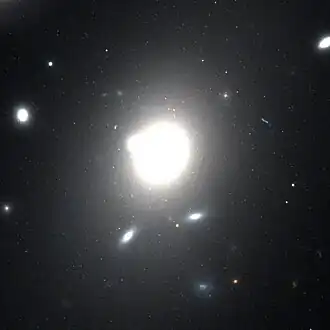ESO 444-46
| ESO 444-46 | |
|---|---|
 HST image of the elliptical galaxy ESO 444-46. | |
| Observation data (J2000 epoch) | |
| Constellation | Centaurus |
| Right ascension | 13h 27m 56.9ss[1] |
| Declination | −31° 29′ 44″[1] |
| Redshift | 0.046902±0.000070[1] |
| Heliocentric radial velocity | 14,061±21 km/s[1] |
| Galactocentric velocity | 13,921±22 km/s[1] |
| Distance | 654.9 ± 45.99 Mly (200.8 ± 14.1 Mpc)h−1 0.6774 (Comoving)[1] 667 Mly (204.5 Mpc)h−1 0.6774 (Light-travel) |
| Group or cluster | Abell 3558 |
| Apparent magnitude (V) | 12.6[1] |
| Characteristics | |
| Type | cD;E+4;BrClG[1] |
| Size | 670,710 ly × 382,320 ly (205.64 kpc × 117.22 kpc) (diameter; 27.0 B-mag arcsec−2)[1][a] 450,940 ly × 315,650 ly (138.26 kpc × 96.78 kpc) (diameter; "total" magnitude)[1][a] |
| Apparent size (V) | 1.7′ × 1.2′[1] |
| Notable features | Large globular cluster population |
| Other designations | |
| ESO 444- G 046,[1] MCG −05-32-026,[1] PGC 047202,[1] Shapley 8-1[1] | |
ESO 444-46 (Shapley 8-1, A3558-M1) is a class E4 supergiant elliptical galaxy;[2] the dominant and brightest member of the Abell 3558 galaxy cluster around 200.8 megaparsecs (654.9 million light-years) away in the constellation Centaurus.[2][3][4][1] It lies within the core of the massive Shapley Supercluster, one of the closest neighboring superclusters.[5] It is one of the largest galaxies in the local universe, and possibly contains one of the most massive black holes known. The black hole's mass is very uncertain, with estimates ranging from as low as 501 million M☉, to as high as 77.6 billion M☉.[6][7]
Physical characteristics
Globular clusters
ESO 444-46 has an estimated population of about 27,000 globular clusters which may be one of the largest populations ever studied. This is in contrast to 15,000 globular clusters in Messier 87, and 200 in the Milky Way. However, this large number may be due to the addition of Intracluster globular clusters since the galaxy lies about 1 arcmin of the center of Abell 3558.[8]
Supermassive black hole
A calculation using the spheroidal luminosity method by estimating the stellar density of the central region using its brightness, yielded a mass of 77.6 billion solar masses (with the range being 22 billion M☉ to 270 billion M☉).[6][7] This would make it one of the most massive black holes known – nearly twelve times the mass of the black hole in Messier 87, and 18,000 times more massive than Sagittarius A*, the Milky Way's central black hole. A black hole of this mass has a Schwarzschild radius of 1,530 AU (about 461 billion km in diameter).
Alternative calculations using the M-sigma relation and the newer core break radius method yielded estimates of 500 million M☉ and 27 billion M☉, respectively.[6][7]
See also
- List of galaxies
- List of nearest galaxies
- List of NGC objects (4001–5000)
- List of spiral galaxies
- NGC 4889
- NGC 4874
- IC 1101
Notes
- ^ a b The quick-look major axis physical diameters given by NED of 183.41 by 104.55 kiloparsecs (598,000 by 341,000 light-years) and 123.32 by 86.32 kiloparsecs (402,000 by 282,000 light-years) were based on a distance estimate of 179.0 ± 45.255 megaparsecs (583.8 ± 147.6 million light-years). The quoted diameters in this infobox were based on NED's provided scale "Virgo + GA + Shapley" of 973 parsecs/arcsec multiplied by the given angular diameters.
References
- ^ a b c d e f g h i j k l m n o p "Detailed Information for Object ESO 444- G 046". NASA/IPAC Extragalactic Database. Retrieved 2018-04-12.
- ^ a b "Central Shapley Supercluster (Abell 3558)". chart32.de. Retrieved 2018-04-12.
- ^ Loubser, S. I.; Sansom, A. E.; Sánchez-Blázquez, P.; Soechting, I. K.; Bromage, G. E. (2008-12-11). "Radial kinematics of brightest cluster galaxies". Monthly Notices of the Royal Astronomical Society. 391 (3): 1009–1028. arXiv:0808.1521. Bibcode:2008MNRAS.391.1009L. doi:10.1111/j.1365-2966.2008.13813.x. ISSN 0035-8711. S2CID 9364497.
- ^ "ESO 444-46". Retrieved 2018-04-12.
- ^ "The Shapley Supercluster". www.atlasoftheuniverse.com. Retrieved 2018-04-12.
- ^ a b c Dullo, B.T. (22 November 2019). "The Most Massive Galaxies with Large Depleted Cores: Structural Parameter Relations and Black Hole Masses". The Astrophysical Journal. 886 (2): 80. arXiv:1910.10240. Bibcode:2019ApJ...886...80D. doi:10.3847/1538-4357/ab4d4f. S2CID 204838306.
- ^ a b c Dullo, B.T.; de Paz, A.G.; Knapen, J.H. (18 February 2021). "Ultramassive black holes in the most massive galaxies: MBH−σ versus MBH−Rb". The Astrophysical Journal. 908 (2): 134. arXiv:2012.04471. Bibcode:2021ApJ...908..134D. doi:10.3847/1538-4357/abceae. S2CID 227745078.
- ^ Barber DeGraaff, Regina Grace (August 2011). "A Study of Globular Cluster Systems in the Shapley Supercluster Region with the Hubble Space Telescope" (PDF). Washington State University Libraries. Archived from the original (PDF) on 2021-09-09. Retrieved 2018-04-12.
External links
- ESO 444-46 on WikiSky: DSS2, SDSS, GALEX, IRAS, Hydrogen α, X-Ray, Astrophoto, Sky Map, Articles and images